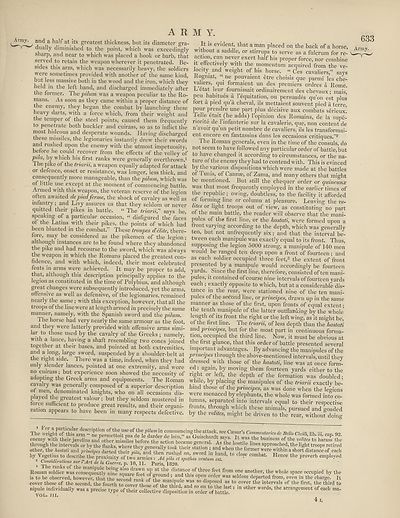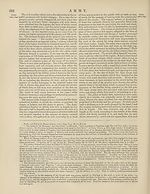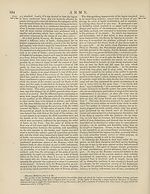Encyclopaedia Britannica > Volume 3, Anatomy-Astronomy
(641) Page 633
Download files
Complete book:
Individual page:
Thumbnail gallery: Grid view | List view

ARM Y.
Army.
and a half at its greatest thickness, but its diameter gra¬
dually diminished to the point, which was exceedingly
sharp, and near to which was placed a hook or barb, that
served to retain the weapon wherever it penetrated. Be¬
sides this arm, which was necessarily heavy, the soldiers
were sometimes provided with another of the same kind,
but less massive both in the wood and the iron, which they
held in the left hand, and discharged immediately after
the former. The pilum was a weapon peculiar to the Ro¬
mans. As soon as they came within a proper distance of
the enemy, they began the combat by launching these
heavy darts, with a force which, from their weight and
the temper of the steel points, caused them frequently
to penetrate both buckler and cuirass, so as to inflict the
most hideous and desperate wounds. Having discharged
these missiles, the legionaries instantly drew their swords
and rushed upon the enemy with the utmost impetuosity,
befoi e he could recover from the effects of the volley of
pilu, by which his first ranks were generally overthrown.1
Ihe pike of the triai'ii, a weapon equally adapted for attack
or defence, onset or resistance, was longer, less thick, and
consequently more manageable, than t\\epilum, which was
of little use except at the moment of commencing battle.
Armed with this weapon, the veteran reserve of the legion
often awaited depiedferme, the shock of cavalry as well as
infantry; and Livy assures us that they seldom or never
quitted their pikes in battle. “ The triarii,'' says he,
speaking of a particular occasion, “ disfigured the faces
of the Latins with their pikes, the points of which had
been blunted in the combat.” These troupes d!elite, there¬
fore, may be considered as the pikemen of the legion;
although instances are to be found where they abandoned
the pike and had recourse to the sword, which was always
the weapon m which the Romans placed the greatest con¬
fidence, and with which, indeed, their most celebrated
feats in arms were achieved. It may be proper to add,
that, although this description principally applies to the
legion as constituted in the time of Polybius, and although
great changes were subsequently introduced, yet the arms,
offensive as well as defensive, of the legionaries, remained
nearly the same ; with this exception, however, that all the
troops of the line were at length armed in precisely the same
manner, namely, with the Spanish sword and the pilum.
Ihe horse had very nearly the same armour as the foot,
and they were latterly provided with offensive arms simi¬
lar to those used by the cavalry of the Greeks ; namely,
with a lance, having a shaft resembling two cones joined
together at their bases, and pointed at both extremities,
and a long, large sword, suspended by a shoulder-belt at
the right side. There was a time, indeed, when they had
only slender lances, pointed at one extremity, and wore
no cuirass; but experience soon showed the necessity of
adopting the Greek arms and equipments. The Roman
cavalry was generally composed of a superior description
of men, denominated knights, who on all occasions dis¬
played the greatest valour; but they seldom mustered in
force sufficient to produce great results, and their organi¬
zation appears to have been in many respects defective.
It is evident, that a man placed on the back of a horse,
without a saddle, or stirrups to serve as a fulcrum for re¬
action, can never exert half his proper force, nor combine
it effectively with the momentum acquired from the ve¬
locity and weight of his horse. “ Ces cavaliers,” says
Kogmat, “ ne pouvaient etre choisis que parmi les che¬
valiers, qui formaient un des premiers ordres a Rome.
Letat leur fournissait ordinairement des chevaux; mais,
peu habitues a fequitation, ou persuades qu’on est plus
fort a pied qua cheval, ils mettaient souvent pied a terre,
pour prendre une part plus decisive aux combats serieux!
Telle etait (he adds) 1’opinion des Romains, de la supe-
riorite de 1 infanterie sur la cavalerie, que, non content de
n avoir qu un petit nombre de cavaliers, ils les transformai-
ent encore en fantassins dans les occasions critiques.”2
The Roman generals, even in the time of the consuls, do
not seem to have followed any particular order of battle, but
to have changed it according to circumstances, or the na-
tui e of the enemy they had to contend with. This is evinced
by the various dispositions which were made at the battles
of I unis, of Cannae, of Zama, and many others that might
be mentioned. But still the chequer order or quincunx
was that most frequently employed in the earlier times of
the republic; owing, doubtless, to the facility it afforded
of forming line or column at pleasure. Leaving the ve-
htes or light troops out of view, as constituting no part
of the main battle, the reader will observe that the mani-
pules of the first line, or the hastati, were formed upon a
front varying according to the depth, which was generally
ten, but not unfrequently six; and that the interval be¬
tween each manipule was exactly equal to its front. Thus,
supposing the legion 5000 strong, a manipule of 140 men
would be ranged ten deep upon a front of fourteen ; and
as each soldier occupied three feet,3 the extent of front
presented by a manipule would accordingly be fourteen
yards.. Since the first line, therefore, consisted of ten mani-
pules, it contained of course nine intervals of fourteen yards
each ; exactly opposite to which, but at a considerable dis¬
tance in the rear, were stationed nine of the ten mani-
pules of the second line, or principes, drawn up in the same
manner as those of the first, upon fronts of equal extent;
the tenth manipule of the latter outflanking by the whole
length of its front the right or the left wing, as it might be,
of the first line. The triarii, of less depth than the hastati
<xx\o. principeS) but for the most part in continuous forma-
tion, occupied the third line. Now, it must be obvious at
the first glance, that this order of battle presented several
important advantages. By advancing the manipules of the
principes through the above-mentioned intervals, until they
dressed with those of the hastati, line was at once form¬
ed: again, by moving them fourteen yards either to the
right or left, the depth of the formation was doubled;
while, by placing the manipules of the triarii exactly be¬
hind those of the principes, as was done when the legions
were menaced by elephants, the whole was formed into co¬
lumns, separated into intervals equal to their respective
fronts, through which these animals, pursued and goaded
by the vehtes, might be driven to the rear, without doing
The weight of^thi^am^ne'perme^ttoitras^dele^darder dXnu" T- U 866 Co™nentar.iesde Civili, lib. iii. cap. 92.
enemy with their javdins and other missiles before the action became vemTal'' IsThe hostile8line busmess.0^t^ ve!it^s to harass the
through the intervals or bv the flanks where thev frenov-iK. v. t- j ,e llostl‘e lmes approached, the light troops retired
other, the hastati and principes darted1 their mhi "and thet" i i 1 s a 10j1a'1^ when the former were within a short distance of each
,0^con,bat He”“,he>•"«*
^ Considtrahons sur l Art de la Guerre, "p. 10, 11. Paris, 1820.
Roman soldier was consequently^flne Square fee^ of e-round (ilstafnc^.of tliree ^et from one another, the whole space occupied by the
is to be observed, however thM he second ink of fC ^ thlS °Pe,r °rder1WaS 861(10111 ^parted from, even in the charge. It
cover those of the second, the fourth to cover hoi T S° ^ t0 -C0Ver the intervals of the the <*ird to
nip^individuafiy was a precise type of their collective disposition in o°rdTr oVbattkf ? m ^ W°rdS’ ^ arra^ement of each ma-
4 L
Army.
and a half at its greatest thickness, but its diameter gra¬
dually diminished to the point, which was exceedingly
sharp, and near to which was placed a hook or barb, that
served to retain the weapon wherever it penetrated. Be¬
sides this arm, which was necessarily heavy, the soldiers
were sometimes provided with another of the same kind,
but less massive both in the wood and the iron, which they
held in the left hand, and discharged immediately after
the former. The pilum was a weapon peculiar to the Ro¬
mans. As soon as they came within a proper distance of
the enemy, they began the combat by launching these
heavy darts, with a force which, from their weight and
the temper of the steel points, caused them frequently
to penetrate both buckler and cuirass, so as to inflict the
most hideous and desperate wounds. Having discharged
these missiles, the legionaries instantly drew their swords
and rushed upon the enemy with the utmost impetuosity,
befoi e he could recover from the effects of the volley of
pilu, by which his first ranks were generally overthrown.1
Ihe pike of the triai'ii, a weapon equally adapted for attack
or defence, onset or resistance, was longer, less thick, and
consequently more manageable, than t\\epilum, which was
of little use except at the moment of commencing battle.
Armed with this weapon, the veteran reserve of the legion
often awaited depiedferme, the shock of cavalry as well as
infantry; and Livy assures us that they seldom or never
quitted their pikes in battle. “ The triarii,'' says he,
speaking of a particular occasion, “ disfigured the faces
of the Latins with their pikes, the points of which had
been blunted in the combat.” These troupes d!elite, there¬
fore, may be considered as the pikemen of the legion;
although instances are to be found where they abandoned
the pike and had recourse to the sword, which was always
the weapon m which the Romans placed the greatest con¬
fidence, and with which, indeed, their most celebrated
feats in arms were achieved. It may be proper to add,
that, although this description principally applies to the
legion as constituted in the time of Polybius, and although
great changes were subsequently introduced, yet the arms,
offensive as well as defensive, of the legionaries, remained
nearly the same ; with this exception, however, that all the
troops of the line were at length armed in precisely the same
manner, namely, with the Spanish sword and the pilum.
Ihe horse had very nearly the same armour as the foot,
and they were latterly provided with offensive arms simi¬
lar to those used by the cavalry of the Greeks ; namely,
with a lance, having a shaft resembling two cones joined
together at their bases, and pointed at both extremities,
and a long, large sword, suspended by a shoulder-belt at
the right side. There was a time, indeed, when they had
only slender lances, pointed at one extremity, and wore
no cuirass; but experience soon showed the necessity of
adopting the Greek arms and equipments. The Roman
cavalry was generally composed of a superior description
of men, denominated knights, who on all occasions dis¬
played the greatest valour; but they seldom mustered in
force sufficient to produce great results, and their organi¬
zation appears to have been in many respects defective.
It is evident, that a man placed on the back of a horse,
without a saddle, or stirrups to serve as a fulcrum for re¬
action, can never exert half his proper force, nor combine
it effectively with the momentum acquired from the ve¬
locity and weight of his horse. “ Ces cavaliers,” says
Kogmat, “ ne pouvaient etre choisis que parmi les che¬
valiers, qui formaient un des premiers ordres a Rome.
Letat leur fournissait ordinairement des chevaux; mais,
peu habitues a fequitation, ou persuades qu’on est plus
fort a pied qua cheval, ils mettaient souvent pied a terre,
pour prendre une part plus decisive aux combats serieux!
Telle etait (he adds) 1’opinion des Romains, de la supe-
riorite de 1 infanterie sur la cavalerie, que, non content de
n avoir qu un petit nombre de cavaliers, ils les transformai-
ent encore en fantassins dans les occasions critiques.”2
The Roman generals, even in the time of the consuls, do
not seem to have followed any particular order of battle, but
to have changed it according to circumstances, or the na-
tui e of the enemy they had to contend with. This is evinced
by the various dispositions which were made at the battles
of I unis, of Cannae, of Zama, and many others that might
be mentioned. But still the chequer order or quincunx
was that most frequently employed in the earlier times of
the republic; owing, doubtless, to the facility it afforded
of forming line or column at pleasure. Leaving the ve-
htes or light troops out of view, as constituting no part
of the main battle, the reader will observe that the mani-
pules of the first line, or the hastati, were formed upon a
front varying according to the depth, which was generally
ten, but not unfrequently six; and that the interval be¬
tween each manipule was exactly equal to its front. Thus,
supposing the legion 5000 strong, a manipule of 140 men
would be ranged ten deep upon a front of fourteen ; and
as each soldier occupied three feet,3 the extent of front
presented by a manipule would accordingly be fourteen
yards.. Since the first line, therefore, consisted of ten mani-
pules, it contained of course nine intervals of fourteen yards
each ; exactly opposite to which, but at a considerable dis¬
tance in the rear, were stationed nine of the ten mani-
pules of the second line, or principes, drawn up in the same
manner as those of the first, upon fronts of equal extent;
the tenth manipule of the latter outflanking by the whole
length of its front the right or the left wing, as it might be,
of the first line. The triarii, of less depth than the hastati
<xx\o. principeS) but for the most part in continuous forma-
tion, occupied the third line. Now, it must be obvious at
the first glance, that this order of battle presented several
important advantages. By advancing the manipules of the
principes through the above-mentioned intervals, until they
dressed with those of the hastati, line was at once form¬
ed: again, by moving them fourteen yards either to the
right or left, the depth of the formation was doubled;
while, by placing the manipules of the triarii exactly be¬
hind those of the principes, as was done when the legions
were menaced by elephants, the whole was formed into co¬
lumns, separated into intervals equal to their respective
fronts, through which these animals, pursued and goaded
by the vehtes, might be driven to the rear, without doing
The weight of^thi^am^ne'perme^ttoitras^dele^darder dXnu" T- U 866 Co™nentar.iesde Civili, lib. iii. cap. 92.
enemy with their javdins and other missiles before the action became vemTal'' IsThe hostile8line busmess.0^t^ ve!it^s to harass the
through the intervals or bv the flanks where thev frenov-iK. v. t- j ,e llostl‘e lmes approached, the light troops retired
other, the hastati and principes darted1 their mhi "and thet" i i 1 s a 10j1a'1^ when the former were within a short distance of each
,0^con,bat He”“,he>•"«*
^ Considtrahons sur l Art de la Guerre, "p. 10, 11. Paris, 1820.
Roman soldier was consequently^flne Square fee^ of e-round (ilstafnc^.of tliree ^et from one another, the whole space occupied by the
is to be observed, however thM he second ink of fC ^ thlS °Pe,r °rder1WaS 861(10111 ^parted from, even in the charge. It
cover those of the second, the fourth to cover hoi T S° ^ t0 -C0Ver the intervals of the the <*ird to
nip^individuafiy was a precise type of their collective disposition in o°rdTr oVbattkf ? m ^ W°rdS’ ^ arra^ement of each ma-
4 L
Set display mode to:
![]() Universal Viewer |
Universal Viewer | ![]() Mirador |
Large image | Transcription
Mirador |
Large image | Transcription
Images and transcriptions on this page, including medium image downloads, may be used under the Creative Commons Attribution 4.0 International Licence unless otherwise stated. ![]()
| Encyclopaedia Britannica > Encyclopaedia Britannica > Volume 3, Anatomy-Astronomy > (641) Page 633 |
|---|
| Permanent URL | https://digital.nls.uk/193765681 |
|---|
| Attribution and copyright: |
|
|---|---|
| Shelfmark | EB.16 |
|---|---|
| Description | Ten editions of 'Encyclopaedia Britannica', issued from 1768-1903, in 231 volumes. Originally issued in 100 weekly parts (3 volumes) between 1768 and 1771 by publishers: Colin Macfarquhar and Andrew Bell (Edinburgh); editor: William Smellie: engraver: Andrew Bell. Expanded editions in the 19th century featured more volumes and contributions from leading experts in their fields. Managed and published in Edinburgh up to the 9th edition (25 volumes, from 1875-1889); the 10th edition (1902-1903) re-issued the 9th edition, with 11 supplementary volumes. |
|---|---|
| Additional NLS resources: |
|

